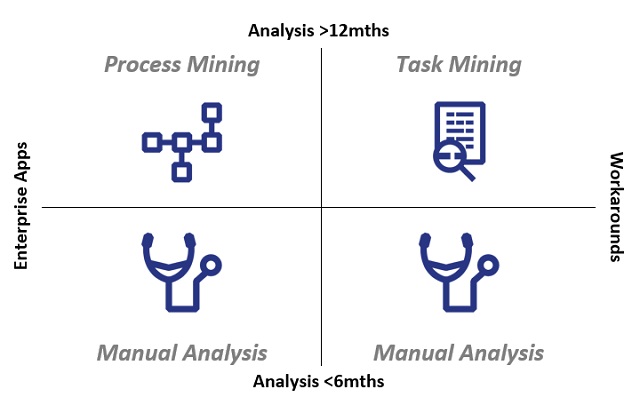If you've ever come across the term "digital twin" you'll likely be aware that it is now possible to have digital representations of physical assets, enabling real-time optimization and cheap simulations. Is the same not also possible for knowledge work i.e. people working on computers instead of machines?
Counterintuitively, as all this work is by definition done "digitally", this is still surprisingly hard to do as it's tricky to collect and analyse the digital "exhaust" given off by all the different systems that people use to do work:
- ERPs (e.g. SAP, Oracle), CRMs (e.g. Salesforce.com, Dynamics) and other enterprise software systems generate event logs capturing what users are doing. These can be accessed via API, but each one will be different in format and require significant analysis to summarise into a process view for example
- Process mining tools (e.g. Minit, Celonis) can solve this by having standard connectors and AI designed to ingest, summarise and visualize event log data into clear process maps that can be analysed in a multitude of ways. It can take time to get reliable data flowing so is best used longer term rather than for a one-off project
- Much work however still happens outside of enterprise systems in MS Office etc. due to every organization needing specific workarounds (e.g. spreadsheets that are managed via email)
- To solve this, task mining tools (e.g. UiPath, Celonis) can be deployed that sit on a user's computer and log keystrokes, mouse clicks etc. hence generating an event log that can be analysed like process mining. Again, it can take time to get reliable data flowing so is best used longer term rather than for a one-off project
In other words, there isn't a single solution that could act as a "digital mesh" to bring together these different sources and provide a single view of your back/middle office operation or contact centre. Which is odd, because everything here is already digital! So what to do?
Firstly, it's probably safe to say that this situation will improve over time with better tools emerging to capture and analyse more activity. If we just focus on those workarounds in Excel etc. for a moment, Microsoft's recent investments in process mining (Minit) and its Power Platform product more generally, suggest that easier-to-access clarity on work outside enterprise systems is coming soon.
Waiting for your preferred vendor to bring the right solution to market isn't really much of a strategy though when you need to make improvements now and aren't sure where to start. The recommendation is hence to look at the problem from 2 different angles:
- For the priority metric you're trying to improve, which process areas have the most impact and hence are most in need of analysis and understanding? Firstly, this will narrow the size of the problem down to what matters, but also confirm which application types the data should come from (e.g. ERP versus MS Office) based on what's used in those processes;
- Is this likely to be a short-term piece of analysis, or a multi-year (perhaps BAU) endeavor to monitor and manage processes in near real time? Only if it's the latter would it currently make sense to invest in implementing process / task mining technologies due to the upfront effort needed to set up and refine data connections etc.
The decision matrix hence looks like this:

For now then, there is still a place for skilled analysts and consultants to find the best improvement levers in an operation, especially when there's uncertainty about which processes have the most impact on a given metric.
Once that's clear, there's then work needed to assess and prioritise processes in terms of their improvement potential, whether through re-engineering or automation or both. Sound familiar?
The content of this article is intended to provide a general guide to the subject matter. Specialist advice should be sought about your specific circumstances.

